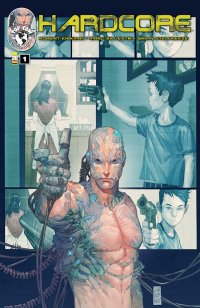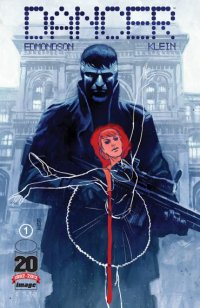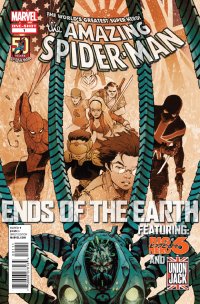Hardcore #1 (Image/Top Cow, $2.99)
by D.S. Randlett
Of all the high concept first issues that Image has been pumping out over the course of the year, very few have hung together in and of themselves. These comics haven’t been particularly bad in any way, they’re often well executed pieces of entertainment, but they hardly satisfy in and of themselves. I’m thinking of something like the first issue of Mind the Gap, which gives the impression that the story is going to really be worth following in a few months. Way too many first issues basically end up functioning as trailers, an announcement of a (hopefully) good creative team and a (hopefully) neat idea.
Which is why the first issue of Hardcore by Robert Kirkman and Brian Stelfreeze is so refreshing. It does everything that a first issue should, by all rights, do. It introduces the cast of the series, as well as the central conflict and MacGuffin. But more than that it tells a story on its own terms, while still leaving plenty of room for future developments. If the series were canceled right now, I would still feel as if I had really experienced the world of Hardcore.
I can be hard on Robert Kirkman’s work sometimes, but this issue in particular showcases all of his best instincts. The dialogue is brisk and often funny, and it feels like there’s something important happening on every page. It’s to his great credit that the cliffhanger here made me smile and want to come back to this world rather than simply hang on to see if anything good develops eventually.
Stelfreeze’s art is also quite good. His style here feels a bit like some of Terry Dodson’s work, or Cully Hamner’s, but it feels unique to him. There’s quite a bit of action in this book, and Stelfreeze relies on his ability to capture motion to convey it. On the whole, his work here feels very choreographed in the best possible way: The action is always fun, exciting, and clear. He also captures the humor and pacing of Kirkman’s so acutely that I can’t imagine this story working with any other artist.
Fans of the Paul Verhoeven classics Robocop and Total Recall will feel right at home here. Those films are obvious touchstones, from the book’s look to the jaundiced and sly tone. Like those films, the sci-fi conceit of Hardcore functions as a vehicle for a bit of social criticism, but at this point the book seems more interested in spinning a yarn than offering a critique. The conceit revolves around an espionage invention called a “hardcore,” a microchip that can be fired into a person’s brain stem that renders them controllable by a government assassination squad for 72 hours. There are some pretty obvious parallels here to some of the more problematic aspects of GWOT like warrantless seizures and botched drone attacks, but those are ideas more present in the concept than the actual unfolding of the narrative. If Hardcore ends up exploring them more explicitly with the verve and humor that this first issue is packed with, it will be a very special series.
Rating: 




Out of a Possible 5 Stars
 BLACK WIDOW: THE NAME OF THE ROSE TPB (Marvel Comics, $16.99)
BLACK WIDOW: THE NAME OF THE ROSE TPB (Marvel Comics, $16.99)
By Devon Sanders
She is one of comics’ most deadly. To new fans of Marvel’s The Avengers movie, she is a master assassin and spy and agent of S.H.I.E.L.D. To comics readers, she’s an Avengers mainstay and former team leader. Unfortunately, to many in comics, she’s also may be best known as Daredevil’s girlfriend. Or Hawkeye’s girlfriend. Or The Winter Soldier’s current girlfriend.
Black Widow is the rare prominent Marvel superheroine to not be introduced as a female version of a male Marvel character. For every Hulk, there must be a She-Hulk. For every Spider-Man, a Spider-Woman. For every Namor, there’s a Namora and damn, even a Namorita.
And there’s the dilemma, while Black Widow was conceived as her own woman; Marvel’s propensity for seconding has come to define how many see her as a character. Heck, even I’ll cop to perceiving her as something less than solo material.
For me, my perceptions of Black Widow began to change not with the movie but with Black Widow: The Name Of The Rose: a story that addresses everything she is, was and very much could be.
In the world of espionage, the greatest commodity is a secret and The Widow, once again, finds herself at the top of its food chain. Deadly enemies, new and old, conspire to bring to light a secret The Black Widow will do everything in her power to protect. What lengths will The Black Widow go to keep to keep it safe?
Writer Marjorie Liu in The Name of The Rose crafts, possibly, the definitive Black Widow tale. Her Widow is whip-smart and most important to a tale of espionage; cunning. In Liu’s symbolism of having Widow be attacked by specific members of former lover Daredevil’s rogues gallery, she makes a significant statement. With Liu brilliantly having Widow formidably dispatch Daredevil’s past, she allows Widow to decisively move forward. This all culminates in a climatic scene in a refrigerator that will make the savvy fan of female comics characters stand up and cheer.
Visuals are beautifully handled by current Avengers artist Daniel Acuna. Acuna’s greatest strength is his ability, through body language, to help tell a story. Whether depicting all-out action sequences or a face-off featuring master assassins sitting, trying to gain an upper hand using nothing but the truth only eyes can betray, Acuna through his art and color palette pulls it all off. In the space of a page, Acuna can have Widow go from icy stare to weariness and in that, I find an immense help to my story enjoyment and goes a long way in an overall understanding and enjoyment of the character and her tale.
By simply telling, a great story; Liu and Acuna have said more about everything the Black Widow is in this one book, than others have over the course of decades.
Black Widow: The Name of The Rose is very much as good a good story as it is a statement.
Rating: 




Out of a Possible 5 Stars
Dancer #1 (Image, $3.99)
By Jeb D.
I’m not sure at what point writing about pop culture shifted largely from criticism (where one discusses a work in detail) to (for want of a better word) the “review,” where one gives general impressions of the work, careful to avoid spoiling anything for fear of undercutting the impact of the creators’ intentions, and just telling the reader that the thing either is, or isn’t worth their money (I suppose the popularity of the Siskel and Ebert school of “Thumbs Up/Down” commentary has something to do with it). And while I’m generally OK with not spoiling important plot twists, that can make things tricky when the very existence of the plot twist is not only kind of the point of the story, but also the main reason for purchasing a comic.
Dancer (which, my colleague Devon Sanders informs me, gestated in a chance encounter that writer Nathan Edmondson had with a ballet dancer at an appearance in Devon’s comic store) is working a time-honored template: an “ordinary” woman finds herself caught up in the dangerous world of a taciturn man of violence. Artist Nic Klein does gritty urban travelogue very well (settings include Brazil and Italy, so far), and if he’s a little vague on facial consistency, the use of long shots and quick-cuts makes that less of a problem than it might otherwise be. The execution is familiar to anyone who’s ever seen a Jason Bourne movie, and competently handled… but after a few pages, you start to realize that it’s all buildup to a reveal that’s on the way. And that’s fine, except that when a question of identity is raised in what is, essentially, a cast of two, the writer’s options get awfully limited.
Now, to be fair to Edmondson, he’s working within the constraints of the continued-story comic series, and if he’d been able to tell the entire story in a single graphic novel (or movie screenplay, which this is trying to pretend not to be), he’d have had more time to let the story develop and breathe; here, he pretty much has to shoot his shot at the end of issue #1 if he wants to get readers back for #2. There’s certainly some “How?” and “Why?” questions that he may still answer in clever and creative ways in issues to come, with more background about our endangered couple. But I think I’ll wait for the trade collection to find out.
Rating: 




Out of a Possible 5 Stars
 The Amazing Spider-Man: Ends of the Earth #1 (Marvel, $3.99)
The Amazing Spider-Man: Ends of the Earth #1 (Marvel, $3.99)
By Jeb D.
Well, now they tell me.
After reading this comic, I spent a bit of time poking around the comics sites, and was informed by more than one commentator that, despite its #1 numbering, this issue actually takes place smack dab in the middle of the current ongoing Spider-Man epic, and that it might not be entirely friendly to the uninitiated. And they weren’t kidding.
Confession: the pressures of time (and, admittedly, some cape and costume ennui) have curtailed my corporate superhero reading in recent months, so despite my admiration for Dan Slott’s handling of Spider-Man, I’m way behind on that series. As a consequence, it was a bit startling to pick up this book and find that not only is Spidey “The World’s Greatest Super-Hero,” and once more public enemy #1, but he’s wearing another fucking suit of armor. I will grant you that it’s subtler than the multi-limbed version that was foisted on us a few years back, but the garishness of that quickly-retired costume was almost the point. I don’t quite know what the point of this one is, because Spidey doesn’t do anything in this issue except talk (Brian Bendis, call your office). Instead, writer Rob Williams positions the webhead as the reluctant leader, and long-distance co-ordinator, of an international team of heroes taking on Doctor Octopus’ latest space-borne scheme for world domination; his contribution to the story consists of dispatching this spandexed League of Nations to try and snatch some of Ock’s super-stealth technology so that it can be reverse-engineered, making it easier to find him and punch him out.
That may sound like snark, but for better or worse, the lip service paid to technology and espionage is just window-dressing for a series of lavish, old-school costumed throwdowns that artist Thony Silas, with inks by Victor Olazaba and colors from Will Quintana, handles with undisguised glee: it’s like six months’ worth of the Avengers/X-Men VS book crammed into thirty pages. Williams comes down awfully heavy on the cultural clichés (Kangaroo would look and sound pretty goddam stupid in any context, but as a “representative” of Australian culture, he’s also unimaginative to a point that feels insulting), with everyone declaiming love of their particular homeland while getting their heads handed to them by their respective baddies. Union Jack is something of an exception (he actually accomplishes something), and while his dialog is as ridden with clichés as any of his teammates, it does seem to have a point, though his musing on things like the long-gone days of good British craftsmanship, and its revival for construction of the Olympic sites, seem distracting coming from a man plunging headlong into battle on a speeding motorcycle. Nothing much is resolved, and I’m left vaguely wondering if the fates of the defeated Kangaroo, Sabra, and Titanium Man are in any way integral to this event, or if we’ll get one panel in the final installment where we learn that they’re all right.
And that’s only half the book! The other story, written by Brian Clevinger, has Japanese team Big Hero 6 engaging Ock’s forces with a mixture of computer-hacking gobbledygook and mecha; the dialog is so pointless that the word balloons get tiresome to even try to read, but Silas and company once more bring the smash and ‘splode.
Somewhere back in dim antiquity, there’s a version of me that would have found this comic an awesome amount of fun; that is, unless I had bought a Spider-Man comic with the expectation that Spidey would actually do something in it.
Rating: 




Out of a Possible 5 Stars